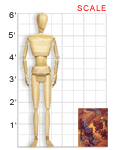VAM galleries including this work:
The Filson Historical Society | Seeing Red || VAM Home
Carrie Douglas Dudley Ewen (Kentucky, 1894-1982)
PAINTER’S STUDIO, c. 1916-1947
Oil on canvas; 19.5" X 25.5"
1986.1.16, Gift of Lu Ann Weinstein
The Filson Historical Society
This depiction of a room furnished with a sofa, an easel, and a chair with a smock draped over it is quite different from Carrie Douglas Dudley Ewen’s other paintings, which tend mainly to be portraits. But one might construe it as a portrait of an artist through a portrayal of her personal space. Artists such as 19th-century Dutch painter Vincent van Gogh painted scenes of rooms that were of value to them. This space was meaningful to Ewen because it was her studio in Chicago. The building in which it was located, on East Erie, was demolished as part of the Magnificent Mile building project in 1947. The numerous paintbrushes and open scissors on the floor make it evident that this is the studio of an active artist. As with van Gogh’s interiors, this scene is presented from an oblique angle.
About the Artist
Carrie Douglas Dudley Ewen was born in 1894 in Flemingsburg, Kentucky. Her father, Charles Lee Dudley, was a Civil War veteran who operated a car service. Her mother, Lula Keener Dudley, liked to indulge her artistic inclinations by painting and probably encouraged her daughter’s artistic interests. Carrie began working creatively when she was a child by making paper dolls, a practice she continued later in life.
Ewen moved to Chicago to attend the city’s esteemed Art Institute. After graduating, she decided to stay in Chicago and began making a living doing commercial work. Her diverse assignments ranged from illustrations for children’s tales and recipe books to producing greeting cards for Henri Fayette. Feeling compelled to assume a male pseudonym, she called herself Douglas Ewen. As her niece, Lu Ann Weinstein remembers, “Aunt Doug was making money long before women were supposed to be so uppity.”
Ewen traveled to places like London, Paris, and Milan on business trips with her husband, Jack Ewen, a Frigidaire employee. Throughout this time she continued working on her commercial endeavors. She also wrote and illustrated whimsical and innovative “peek-a-boo” books, in which the cardboard pages contain small windows revealing images on subsequent pages that can be changed at random.
Most of the subjects of Ewen’s stunning portraits were people she was close to, such as her father and her young niece, Lu Ann Bear. Like the picture of her studio, these paintings were done for her enjoyment rather than sale. Many people offered to buy her paintings, but she refused, intending to keep them.
Ewen moved back to Kentucky in 1963 to be with her ailing brother, Bruce. She occupied an apartment in Louisville’s York Towers and applied her creativity even to the more mundane facets of life. For instance, in her apartment, she had the carpet removed and the floor painted black. The walls were a shade of yellow, and the accents of the rooms were turquoise.
In the last years of her life, Ewen continued to design Christmas cards, creating scenes of jolly Santas, winsome angels, ice-skating snowmen, and Louisville streets. She lived in Louisville until her death in 1982 and is buried in her hometown of Flemingsburg.
Classroom Ideas
Discussion: What objects are shown in this painting? If you did not know the title of the work, would you have guessed that it depicts an artist’s studio? Does it tell you anything about the artist? Do any of the objects in the studio give you an idea of the time period in which this work was created? What is the focus of this painting? Why are your eyes drawn to that part of the painting?
Have you ever thought of illustrating books as a way for artists to earn a living? Bring in a favorite illustrated book and share it with the class. Discuss how the illustrations add to the story.
Activity: Do you have a room or space that is special to you? Draw this place, making the drawing a “portrait” of you by including items that are important to you or activities you do in your special place.Links
See other works by Ewen and find out about the artist at the Filson Historical Society web site.
[www.filsonhistorical.org/dougexhibit.html]


